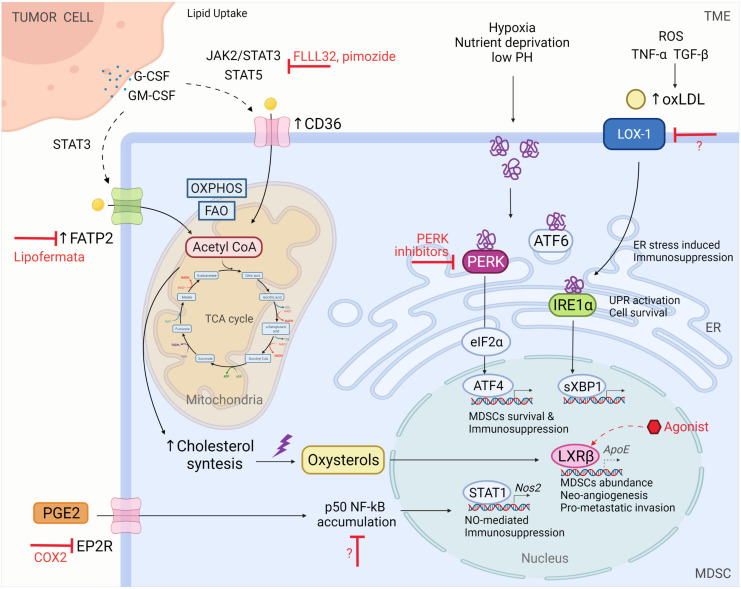Figure 3.
Lipid homeostasis disruption mediates MDSC immunosuppressive function. To sustain their suppressive and tumorigenic functions, MDSCs boost fatty acids oxidation (FAO) and oxidative phosphorylation (OXPHOS). FAO produces Acetyl-CoA, which is essential for ATP and endogenous lipid synthesis. Meanwhile, exogenous fatty acid (FA) uptake occurs thanks to the upregulation of FA transporters such as CD36 and fatty acid transport proteins (FATPs) on the cell surface. Among the broad set of lipids by which MDSCs are replenished, there is arachidonic acid, relevant for prostaglandin E2 (PGE2) production. PGE2 drives nuclear accumulation of p50 protein of NF-κB, necessary for NO production and NO-mediated immunosuppression. On the other side, the hostile nature of the tumor-microenvironment (TME) induces calcium and lipid homeostasis disruption leading to ER stress and, as a consequence, unfolded protein response (UPR) activation. Oxidative stress conditions also mean lipid oxidation: while oxidized low-density lipoproteins (ox-LDLs) from the TME mediate ER stress-induced immunosuppression involving LDL receptor-1 (LOX-1) receptor, oxysterols through the liver-X nuclear receptor (LXR)/ apoliprotein E (ApoE) axis mediate MDSCs survival and abundance, regulating cholesterol and lipid metabolism. FA, fatty acids; FATP2, fatty acid transport protein 2; ROS, reactive oxygen species; TNF-α, tumour necrosis factor α; TGF-β, transforming growth factor β; oxLDL, oxidized low-density lipoprotein (LDL); Nos2, nitric oxide synthase 2; LXRβ, liver-X β nuclear receptor; PERK, RNA (PXR)-like ER kinase; IRE1α, inositol-requiring enzyme 1; eIF2α, eukaryotic initiation factor 2 α; sXBP1, spliced X-box binding protein-1; EP2R, PGE2 receptor; COX2, cyclooxygenase 2.

